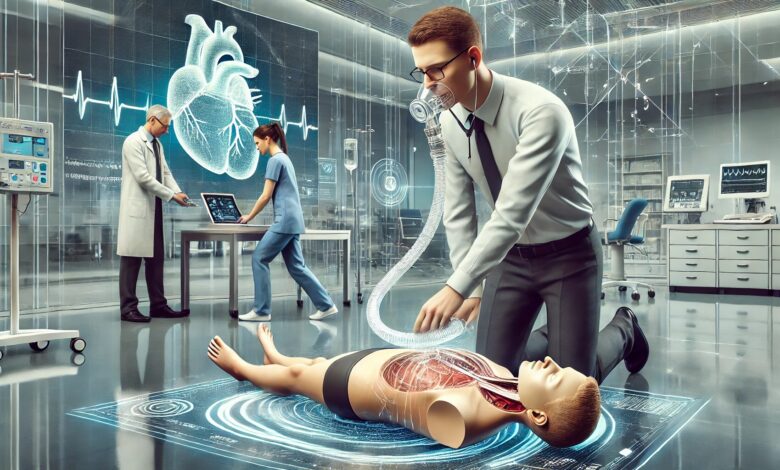How is CPR Performed Differently When an Advanced Airway is in Place?
Understanding the Key Differences in CPR Procedures with Advanced Airway Management

Cardiopulmonary resuscitation (CPR) is a life-saving technique used during cardiac arrest to maintain blood circulation and oxygen delivery to vital organs. Traditional CPR techniques involve alternating chest compressions and rescue breaths. However, when an advanced airway is in place—such as an endotracheal tube or a laryngeal mask airway—CPR techniques are modified to improve effectiveness and efficiency. This article will explore the differences in CPR procedures when an advanced airway is used and how it impacts patient outcomes.
Table of Contents
ToggleUnderstanding the Role of an Advanced Airway
An advanced airway refers to a device used to secure the airway during CPR and improve oxygenation. These devices include endotracheal tubes and supraglottic airway devices like the laryngeal mask airway (LMA). They are often used in advanced life support (ALS) settings by healthcare providers to maintain a clear airway, allow for more controlled ventilation, and ensure the airway remains open during resuscitation efforts.
Key Devices in Advanced Airway Management
-
Endotracheal Tube Ventilation: This tube is inserted into the trachea through the mouth or nose, securing the airway and allowing for effective ventilation and oxygenation.
-
Laryngeal Mask Airway (LMA): This is a less invasive airway device inserted into the throat that sits above the trachea. It provides a secure airway for ventilation.
When an advanced airway is in place, traditional CPR is modified to prioritize continuous chest compressions and synchronized ventilation.
How CPR is Performed with an Advanced Airway
Continuous Chest Compressions
One of the primary differences in performing CPR with an advanced airway is the emphasis on continuous chest compressions. With an advanced airway in place, chest compressions are uninterrupted by pauses for rescue breaths. This is a critical change as it helps maintain a consistent flow of blood to vital organs, particularly the brain and heart.
Why Continuous Compressions Matter:
-
Uninterrupted chest compressions ensure that oxygenated blood continues to circulate throughout the body.
-
Reduced interruption to compressions leads to more effective blood flow, which increases the chances of survival during cardiac arrest.
-
This technique aligns with current ACLS guidelines for CPR with advanced airway, which recommend continuous chest compressions without pausing for ventilations.
Ventilations with an Advanced Airway
Unlike traditional CPR, where the compression-to-ventilation ratio is typically 30:2 (30 compressions followed by 2 breaths), CPR with an advanced airway requires asynchronous ventilation. This means that while chest compressions continue without interruption, ventilations are given separately.
Ventilation Rate with Advanced Airway:
-
The recommended ventilation rate with advanced airway is typically 1 breath every 6 seconds, which equates to about 10 breaths per minute.
-
This is different from traditional CPR, where ventilations are typically delivered during pauses between chest compressions.
The key goal is to maintain adequate oxygenation while ensuring chest compressions continue to circulate blood effectively throughout the body.
Key Differences Between Standard CPR and CPR with Advanced Airway
1. Pauses for Breaths vs. Continuous Compressions
-
Traditional CPR: In traditional CPR without an advanced airway, a pause is taken every 30 compressions to deliver 2 breaths.
-
CPR with Advanced Airway: With an advanced airway, there are no pauses for breaths. Instead, ventilations are administered asynchronously while chest compressions are ongoing. This leads to more continuous blood flow to the organs and improves overall oxygenation.
2. Role of the Rescuer
In CPR with an advanced airway, the roles of the rescuers become more specialized:
-
One person typically focuses on maintaining the advanced airway and delivering breaths.
-
The other focuses solely on performing high-quality chest compressions to ensure optimal blood flow.
This division of labor allows both tasks to be performed effectively without compromising the other.
3. Use of Mechanical CPR Devices
In some cases, mechanical CPR devices can be used in situations where manual compressions are not feasible or when there is a need for continuous compressions for prolonged periods. These devices can work in tandem with an advanced airway and improve the overall success of resuscitation efforts.
Examples of Mechanical CPR Devices:
-
LUCAS device: Provides high-quality chest compressions at a constant rate and depth, supporting the maintenance of circulation without interruption.
-
AutoPulse: Another mechanical CPR device that helps maintain continuous compressions and can be used when advanced airway management is in place.
Advanced Life Support (ALS) and the Role of Airway Management
In Advanced Life Support (ALS), when an advanced airway is in place, healthcare providers focus on high-quality chest compressions, proper ventilation, and minimizing interruptions. The presence of an advanced airway allows for better control of the airway, reducing the risks of airway obstruction and improper ventilation during resuscitation.
Capnography Monitoring
Another essential aspect of airway management during CPR with an advanced airway is capnography monitoring. This device measures exhaled carbon dioxide (CO2), providing valuable information about the effectiveness of chest compressions and the ventilation being delivered.
-
Capnography is used to assess the quality of chest compressions and ensure that oxygen is being effectively delivered to the lungs.
-
It is especially useful for tracking the progress of resuscitation and confirming proper endotracheal intubation during CPR.
Defibrillation and CPR with Advanced Airway
When an advanced airway is in place, the procedure for defibrillation does not change. Chest compressions should be paused during the shock delivery to allow for effective defibrillation. After the shock is delivered, chest compressions are immediately resumed. The presence of an advanced airway does not affect the procedure for defibrillation, but it can improve the quality of ventilation and oxygenation during post-shock resuscitation.
FAQs About CPR with Advanced Airway
1. Why are chest compressions continuous with an advanced airway?
With an advanced airway, chest compressions are continuous because they ensure the uninterrupted circulation of blood to vital organs. Pauses for breaths are avoided to maintain blood flow.
2. How often should ventilations be given when an advanced airway is in place?
When an advanced airway is in place, ventilations should be delivered at a rate of 1 breath every 6 seconds, or approximately 10 breaths per minute.
3. Can mechanical CPR devices be used with an advanced airway?
Yes, mechanical CPR devices can be used with an advanced airway. These devices provide consistent chest compressions while the advanced airway maintains the patient’s oxygenation.
4. What is the role of capnography during CPR with an advanced airway?
Capnography helps monitor the effectiveness of ventilations and chest compressions during CPR. It ensures that the patient is receiving adequate oxygenation and that the chest compressions are effective.
5. How does the presence of an advanced airway affect CPR in cardiac arrest?
An advanced airway ensures that ventilation is more controlled and uninterrupted by compressions, optimizing oxygen delivery to vital organs while maintaining continuous chest compressions for better circulation.
Conclusion
Performing CPR with an advanced airway in place significantly alters the approach to chest compressions and ventilation. The primary focus is on continuous chest compressions, with ventilations provided asynchronously, ensuring optimal circulation and oxygenation. The use of advanced airway devices such as endotracheal tubes and laryngeal masks improves airway management, allowing for better control and more effective resuscitation. The application of mechanical CPR devices, capnography, and ACLS guidelines ensures that both compressions and ventilations are delivered efficiently, improving the likelihood of survival during cardiac arrest.



